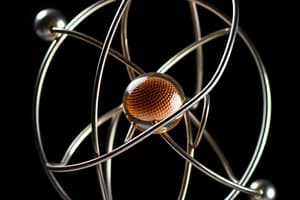Podcast
Questions and Answers
Who proposed the plum pudding model of the atom?
Who proposed the plum pudding model of the atom?
- Ernest Rutherford
- Niels Bohr
- J.J. Thomson (correct)
- Albert Einstein
Rutherford's planetary model of the atom was proposed in 1911.
Rutherford's planetary model of the atom was proposed in 1911.
True (A)
What particles were used as sources in Rutherford's scattering experiment?
What particles were used as sources in Rutherford's scattering experiment?
Alpha particles
The ___ model was developed by Niels Bohr.
The ___ model was developed by Niels Bohr.
What was the thickness of the gold foil used in the scattering experiment?
What was the thickness of the gold foil used in the scattering experiment?
Match the following scientists with their contributions to atomic theory:
Match the following scientists with their contributions to atomic theory:
The alpha particles produced bright flashes on the zinc sulphide screen during the experiment.
The alpha particles produced bright flashes on the zinc sulphide screen during the experiment.
Rutherford's experiment involved a beam of alpha particles with an energy of ___ MeV.
Rutherford's experiment involved a beam of alpha particles with an energy of ___ MeV.
Flashcards are hidden until you start studying
Study Notes
Atomic Models
- J.J. Thomson proposed the plum pudding model of the atom in 1898
- Rutherford refined Thomson's model, calling it the planetary model of the atom in 1911
- Niels Bohr developed the Bohr model of the hydrogen atom in 1913
Rutherford’s Alpha Particle Scattering Experiment
- Conducted in 1911 by H. Geiger and E. Marsden under the guidance of Ernest Rutherford
- Used a beam of alpha particles (5.5 MeV) from a source of Bismuth-214 (83 Bi)
- Alpha particles directed at a thin gold foil (2.1 x 10-7 m thick)
- Scattered alpha particles were detected by a rotatable detector consisting of a zinc sulphide screen and a microscope
- The experiment aimed to study the structure of the atom by observing how alpha particles interact with matter
- The results of the experiment led to the discovery of the atomic nucleus
- The observations were primarily: Most alpha particles passed straight through the gold foil with no deflection, some particles were deflected through small angles, and a few particles were deflected at large angles, even back towards the source
Key Observations and Interpretations
- Most alpha particles pass through the gold foil undeflected: This indicates that atoms are mostly empty space.
- Some alpha particles are deflected through small angles: This suggests that there are positive charges within the atom, causing a repulsion of the positively charged alpha particles.
- A few alpha particles are deflected at large angles, even back towards the source: This suggests that a tiny, dense, positively charged region exists in the atom, which we now call the nucleus
Rutherford's Model
- Proposed that the atom consists of a small, dense, positively charged nucleus at the center
- Negatively charged electrons orbit the nucleus, similar to planets orbiting the sun
- This model accounted for the large-angle scattering of alpha particles, as they would be deflected by the nucleus
- Rutherford's model was a significant improvement over the plum pudding model, but it had limitations in explaining the stability of atoms and the spectral lines emitted by atoms
Studying That Suits You
Use AI to generate personalized quizzes and flashcards to suit your learning preferences.




